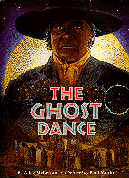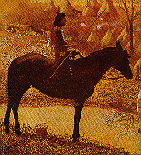

![]()

|
The Ghost Dance.
Alice McLerran. Illustrated by Paul Morin. Subject Headings:
Grades 1 - 6 / Ages 6 - 11.
****/4
|
excerpt:
Dance, said the dream.
Dance to call those ghosts alive again.
Dance, and the white men will all disappear,
their horses and their goods remain.
Dance, and the fish will fill the streams
and buffalo be many.
Dance.
 THE GHOST DANCE relates the history of the Ghost Dance Movements that took place across much of the United States in the late 1800s. The Ghost Dance doctrine envisioned a future in which all Indian nations would be united, hunger and disease would vanish, and the earth would be regenerated and restored.
THE GHOST DANCE relates the history of the Ghost Dance Movements that took place across much of the United States in the late 1800s. The Ghost Dance doctrine envisioned a future in which all Indian nations would be united, hunger and disease would vanish, and the earth would be regenerated and restored.

Author Alice McLerran sees in the tragic history of this sacred ritual an ecological parable for our times, and a vision for a more harmonious future for all who inhabit our planet.
The Ghost Dance is recounted with sensitivity and respect. McLerran's strongly cadenced, lyrical style and evocative language would make this an excellent read-aloud. Sumptuous paintings by award-winning illustrator Paul Morin (Fox Song; The Dragon's Pearl; and The Orphan Boy) complement and enrich the text. In addition to the paintings, Morin makes effective use of assemblage pieces incorporating natural and historical objects such as feathers, wampum beads, bullets, dream catchers, and a medicine pipe.

In the forward to Jon C. Stott's Native Americans in Children's Literature Joseph Bruchac writes:
. . . not only Native people can write about Native Americans, but . . . deep knowledge is necessary for anyone (Native or non-Native) to write well about those essential building blocks of Native American cultures -- the words of their elders, the traditional stories told to their children.Whether or not they have "deep knowledge," both McLerran and Morin obviously do possess an abiding interest in and appreciation for Native cultural and spiritual beliefs; their collaborative efforts have produced a picture book that should speak to a wide audience.
Highly recommended.
MaryLynn Gagne is a Reference Librarian with the Education Library, University of Saskatchewan Libraries.
To comment on this title or this review, send mail to cmeditor@mts.net.
![]()
Copyright © 1996 the Manitoba Library Association.
Reproduction for personal use is permitted only if this copyright notice
is maintained. Any other reproduction is prohibited without permission.
Published by
The Manitoba Library Association
ISSN 1201-9364
![]()